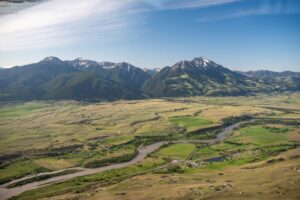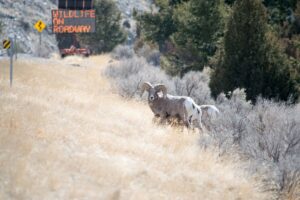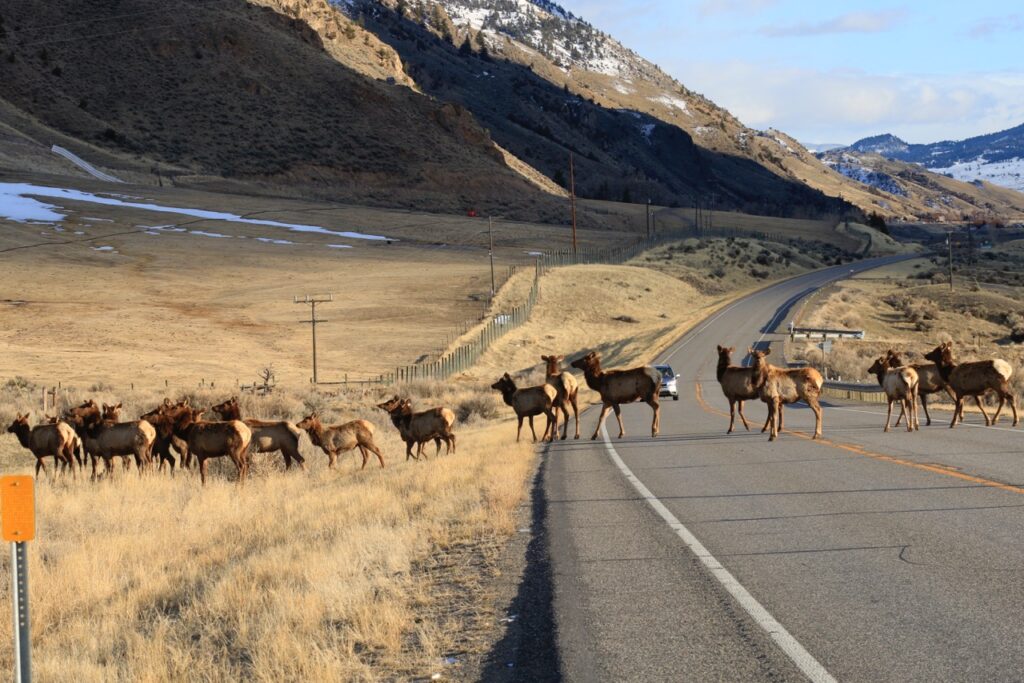
Roughly 50% of all highway accidents on US 89 north of Yellowstone National Park—between Livingston and Gardiner, Montana—are wildlife related. In response to this growing and dangerous problem, a locally led partnership called Yellowstone Safe Passages (YSP) just took a major step toward finding solutions by completing a comprehensive assessment of wildlife-vehicle collisions on this stretch of highway, conducted by the Center for Large Landscape Conservation and YSP partners.
US 89 extends the length of Paradise Valley and the Gardiner Basin, connecting drivers to Yellowstone National Park. Drivers have hit bison, grizzly bears, elk, deer, moose, and more. These accidents are usually fatal for the animal and pose a serious threat to human safety.
But as Center for Large Landscape Conservation Road Ecologist Liz Fairbank explains, it is more than a major safety issue.
“Wildlife traverse the entire valley, often having to cross US 89 to reach vital habitat to the east, west, and south, including Yellowstone National Park and vast swaths of national forest on both the east and west sides of the valley,” says Fairbank. “If they can’t move freely, they might miss out on the food and water sources they need to survive, or on finding mates to help sustain their population.”
The Center for Large Landscape Conservation conducted the US 89 Wildlife & Transportation Assessment alongside Montana State University’s Western Transportation Institute and Montana Freshwater Partners. The recently published assessment details the results of the study, and provides recommendations for possible solutions that could reduce the number of animals struck each year, make the highway safer for drivers, maintain wildlife movement, and even restore access to habitat for some species.
More than 10 years of data from multiple public agencies was provided for analysis in the assessment. In addition, for three years area residents participated as citizen scientists using the ROaDS Tool (Roadkill Observation and Data System) via a smartphone app to record observations of live or dead wildlife along US 89. During that same timespan, a field technician traveled the highway each week to collect additional data and to verify and confirm the observations made by citizen scientists.

The assessment overlays data on human safety, wildlife mortality from collisions, wildlife movement, and habitat connectivity to identify the most important areas along the highway to consider for mitigation measures. Then these areas were then further evaluated by the researchers and an interagency technical team. The assessment also evaluated all culverts underneath the highway to identify where improvements may be needed for fish passage or to increase the potential of the culverts to serve as safe crossings for small or medium sized species.
“Overall, the assessment identified seven priority sites and a suite of potential solutions for each one ranging from new wildlife crossings—overpasses and underpasses—to retrofits to existing structures, animal detection systems, and fencing,” says Fairbank. “It outlines options for each site, including some short-term measures as well as longer-term solutions such as large crossing structures combined with fencing that may be eligible for federal funding.”
The Common Ground Project originally convened Yellowstone Safe Passages in 2019 to bring together citizens who live, work, and play in the Upper Yellowstone Watershed to explore what could be done about the growing problem of wildlife-vehicle collisions. Since its founding, YSP has gathered an impressive cross-section of partners—including public agencies and officials, private foundations and conservation groups, anglers, and local land and business owners—that demonstrates that the community is invested in finding solutions.
The founding members of YSP include representatives from the Common Ground Project, Center for Large Landscape Conservation, Greater Yellowstone Coalition, National Parks Conservation Association, and Park County Environmental Council.
The comprehensive assessment and a shorter “Key Findings” document are now available online, and Yellowstone Safe Passages plans to share the results of the assessment with residents of Park County, Montana, via community information sessions in the spring of 2024.
For more information, visit yellowstonesafepassages.org/highway-assessment
Funding for the US 89 Wildlife & Transportation Assessment was provided by AMB West Conservation Fund, the Greater Yellowstone Coalition, and Yellowstone Safe Passages.
Top photo: A herd of elk crosses US 89. Credit: Hallie Rugheimer



